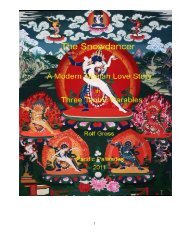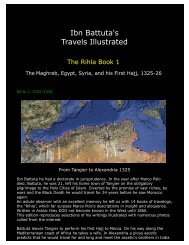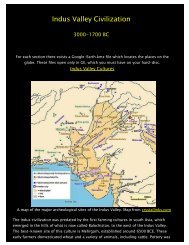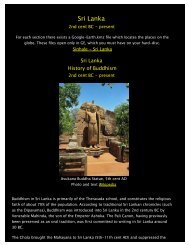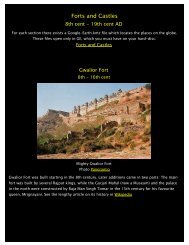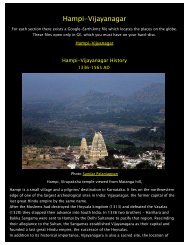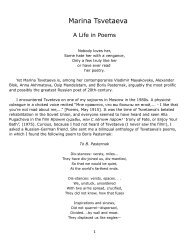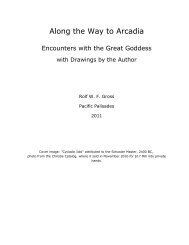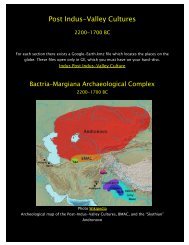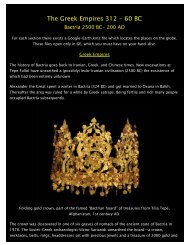Gandhara - Rolf Gross
Gandhara - Rolf Gross
Gandhara - Rolf Gross
- No tags were found...
Create successful ePaper yourself
Turn your PDF publications into a flip-book with our unique Google optimized e-Paper software.
<strong>Gandhara</strong>10th cent BC - 11th cent ADFor each section there exists a Google-Earth.kmz file which locates the places on theglobe. These files open only in GE, which you must have on your hard-disc.GE Overlay Map: <strong>Gandhara</strong> OverlayBuddhist <strong>Gandhara</strong>The center of <strong>Gandhara</strong> was located mainly in the valley of Peshawar, the Potoharplateau (Taxila) and on the Kabul River. Its main cities were Purushapura (modernPeshawar) and Takshashila (modern Taxila). The Kingdom of <strong>Gandhara</strong> lasted from early1st millennium BC to the 11th century AD. It attained its height from the 1st century tothe 5th century under the Buddhist Kushan Kings. After it was conquered by Mahmud ofGhazni in 1021 AD, the name <strong>Gandhara</strong> disappeared. During the Muslim period the areawas administered from Lahore or from Kabul. During Mughal times the area was part ofKabul province.The region shows an influx of southern Central Asian culture in the Bronze Age with the<strong>Gandhara</strong> grave culture showing a continuum between the early neolithic culture withclose ties and relations to the Bactria-Margiana Archaeological Complex. This culturesurvived till 600 BC. Its evidence has been discovered in the hilly regions of the Swat andDir, and even at Taxila (Malayo, Melanesian, Wabanaki, Nahuatl Cultures)For further reading: Wikipedia
Buddhist <strong>Gandhara</strong>180 BC- 11th cent ADThe Kingdoms of <strong>Gandhara</strong> (Greco-Bactrians, Sakas, and Indo-Parthians) lasted from180 BC to the 11th century. Ghandara attained its height during the 1st - 5th cent ADunder the Buddhist Kushan emperors. After that it was conquered by Mahmud of Ghazniin 1021 AD, the area became Moslem and the name <strong>Gandhara</strong> disappeared.<strong>Gandhara</strong> is noted for the distinctive <strong>Gandhara</strong> style of Buddhist art, a consequence of aunique merger of Hellenistic, Syrian, Persian, and Indian artistic traditions. Thisdevelopment started in the Parthian Period (50 BC – 75 AD). The visual appearance ofthe Greco-<strong>Gandhara</strong>n sculptures is most intriguing. Three examples follow (Text andimages from Wikipedia)chiton, <strong>Gandhara</strong>n Greco-Buddhist sculpture from Hadda , 1st cent AD
The Buddha with Herakles as Vajrapani, <strong>Gandhara</strong>n Greco-Buddhist relief, 2nd-3rd cent AD/P>The Buddha's Paranirvana, 2nd-3rd centPhotos WikipediaFor a detailed time table see the History of Ghandara and Afghanistan,5th Millenium BC - 2001 AD
The Swat3000 BC- 800 ADThe very recently (Oct. 2007) mutilated rock-carved Buddha near Janabad,Swat, 7th-8th cent. ADPhoto flickr.comThe Swat comprises several valleys which empty into the Swat river. The area has beeninhabited since prehistoric times (3rd millenia BC).Around the 3rd cent AD it became an important Buddhist center (Udayana). Some 1400stupas and monasteries were spread throughout the valley. The Chinese travelers Faxian(337 - 422 AD) and Xuanzang (602 - 664 AD) have left us detailed descriptions of thesetimes.The Tibetan-Buddhist Tantrayana (9th-11th cent AD) probably originated here andspread from the Swat to Tibet. Padmasambhava is said to have been born in the Swat,the "Guru from Udayana".In the 11th cent AD Islam was introduced by Mahmud of Ghazni who invaded the area.The Buddhist monuments went into decay and have only recently been excavated. TheSwat became part of Pakistan during the Indian division.For Information on the Harappan culture 3200-2600 BC see Wikipedia, Early HarappanThe Swat Grave Culture 1600 - 500 BC at Aligrama is described in Wikipedia, <strong>Gandhara</strong>Grave CultureA cultural history of the Swat is found at Svatvalley.comArcheological maps by the Italian excavators of the Swat are found as a pdf at isiao.it
Udegram, Swat10th cent BC - 14th cent ADUdegram is located 8 kilometres from Saidu Sharif. Aurel Stein identified this with Ora, acity where Alexander fought one of his battles. Italians excavated this site in theThe "Bazaar"excavation site of the lower city (Arrian’s Ora) which Alexander stormed in 326 BC. In asecond level area further downhill the monumental remains of an entire vast inhabiteddistrict were brought to light (Gullini called it a “bazaar” so that, as Tucci wrote,“Alexander’s presence may gently blow all around us”) and was dated between the endof the 4th century BC and the 4th century AD."Photo and text quoted from Centroscavitorino.it
Gogdara Rock CarvingsSwat12th cent BC - 400 ADGogdara's prehistoric rock carvingsPhoto centrovitorino.itBased on sherds found, the settlement was inhabited continously between the 12th cent. BC andthe Parthian period.
Taxila,6th cent BC - 5th cent ADThe Stupa at Taxila-Sirkap, decorated with Hindu, Buddhist, and Greek tsculpturesPhoto and text from WikipediaTaxila is an archaeological site in Pakistan containing the ruins of the <strong>Gandhara</strong>n city ofTakshashila (also Takkasila or Taxila) an important Vedic/Hindu and Buddhist centre oflearning from the 6th BC century to the 5th cent AD. Taxila lay at the crossroads ofthree major trade routes: the royal highway from Pa?aliputra; the north-western routethrough Bactria, Kapisha, and Puskalavati (Peshawar); and the route from Kashmir andCentral Asia, via Srinigar, Mansehra, and the Haripur valley across the Khunjerab pass tothe Silk Road.In 326 BC Alexander the Great received the submission of Ambhi, king of Taxila.During the reign of Ashoka (3nd cent AD), Taxila became an influential centre ofBuddhist learning.Assorted Greek satraps held sway in Taxila until in 460–470 AD the Ephthalites sweeptover <strong>Gandhara</strong> and the Punjab, resulting in the destruction of Buddhist monasteries andstupas at Taxila. The invasion of Islam in the 8th cent AD did the rest.For an excellent, detailed article on the art and history of Taxila see Jona Lendering,Livius.com
Begram2nd cent ADBegram, was founded as Alexandria Caucasia by Alexander the Great. It later became thesummer residence of the Kushan emperors in the 2nd cent ADIvory carvings from a trasure found in a merchant's house in Begram2nd cent ADLarge plaque with engraved decoration, with a girl playing a flute and a woman at thefoot of a tree.
River Deity standing on a makara.A woman and child and a pair of ladies in a doorway.Within walking distance of the US military airfield at the site of the ancient AlexandriaCaucasia a treasure of some 200 sophisticated Greco-<strong>Gandhara</strong>n ivory objects wasfound. Most likely the contents of a warehouse of an exporter of ivories carved in the
area. The panels and sculptures depict scenes of ordinary and royal court life.These items and several more from the Kabul Treasure were recenyly exhibuted at theMusee Guimet in ParisThe Guimet's catalogue asks the question:"Should we view this as a Kushan collection from Augustus’s era (1st century AD) oreven of Kaniska's (2nd century.), or should we assign a much earlier date, back to theIndo-Parthian period, when the sovereign Gondopharnes governed Taxila, or indeed theIndo-Greek epoch, the time of the very last Greek king in the south of the Hindukush,Hermaios who reigned over Kabul? Whether this Treasure was hidden through fear ofinvasions, was a merchant’s stock or was just a simple collection, even today thecollection refuses to give up its secrets."Text and Photographs from Dorothy Lobel King's blogpage Original photographs ©Thierry Ollivier / Musée Guimet, Paris.Tilia Tepe100 BC - 100 AD
In 1978 the Soviet-Greek archeologist Viktor Sarianidi discovered a citadel at Tillia Tepenear Shebergan dating back to the 1st cent BC and six tombs displaying unprecedentedwealth. The tombs held five women and one man. The bodies were dressed in clothessewn with gold and encrusted with turquoise, garnet and lapis lazuli.The Tilia Tepe Necropolis, Greco-Bactrian-Buddhist gold jewelery find extraordinarywas housed at the Kabul Museum. They miraculously survived the Taliban destruction ina bank safe:This Greco-Baktrian gold pendant with turquoise, garnet, lapis lazuli, carnelians, and pearlsdepicts a lady taming two dragons, 1st cent AD
Belt with depictions of Dionysus riding a lion.1st cent ADClasp with erotes on dolphins.From Dorothy Lobel King's blogpage,Original photographs © Thierry Ollivier / Musée Guimet, Paris.
Takht-i-Bahai1 st - 6th cent ADTakht-i-Bahai was the center of Greco-Buddhism in <strong>Gandhara</strong>. Large ruins of a Buddhistmonastery and an academy are found in a mountain valley. Many of the celebratedGreco-<strong>Gandhara</strong>n Buddhist sculptures in Western museums come from here. A few maystill be in the Peshawar Museum. The monastery is relatively well preserved.Two reliefs from Takht-i-Bahai:Ghandara Buddha Avalokiteshvara
The miraculous birth of the BuddhaPhotos from Le Coq, "Buddhistische Spätantike"Shaikhan Dheriearly 2nd cent ADThe Bactrian Greeks built a new city across the river Jinde from Pushkalavati. This citywas occupied by Parthian, Sakas and Kushans. In 2nd AD, the river changed its courseand the city was relocated to the modern village of Rajar.The city was partly excavated by Ahmad Hasan Dani in 1960’s. There are still manymounds at Mir Ziarat, at Rajar and Shahr-i-Napursan which are unexcavated.Text WikipediaHaritiThis area is where Hariti found a new home. Some say she came from Beiruth with theGreeks, other consider her Iranian, in either case she was a terrible ogress. In Ghandarashe was converted to Buddhism, laying off her child-eating habit. She beomes theprotectress of children and pregnant women. She appears everywhere in <strong>Gandhara</strong>. Later(8th-9 th century) she wandered with Buddhism as far as Japan and Java
Greco-Buddhist sculpture: Hariti with her children in the "House of Naradakha", Shaikhan DehriPhoto Jennifer Gowan, U of OregonHariti with her husband Panchala. A true Hellenistic image.The Greeks identified her with the Greek goddess Tyche for which reason she holds a cornucopia.Photo Wikipedia
Sahri Bahlol2nd - 3rd cent ADI"Yusufzai" Hariti fom the upper Peshawar ValleyThe complete figure.Photo Wikipedia
Greco-Buddhist sculpture of a standing, four-armed Haritiwith a trident from Sahri-Bahlol, 2nd-3rd cent AD.Saidu Sharif, Swat200 - 300 ADSculptural elements from a Buddhist Stupa 200-300 AD.
The Buddha and local disciplesRidersPhotos archart.us
Bamiyan4th cent ADThe Bamiyan Buddha before its destruction in the 1980s.Photo photobucketThe large Buddha of Bamiyan, newly notorious because of its destruction by Talibans inthe 1980s, go back to the Sassanian period (4th cent AD). During the following twocenturies this Iranian-<strong>Gandhara</strong>n Buddha style was carried through Gansu (Bingling Si,Maiji Shan, Zhangye ) deep into China (Lomgmen, Yungang, Leshan), where suchgigantic sculptures were much appreciated at the time.
Shah-i-Dheri, Kanishka Stupa2nd - 6th cent ADThe stupa was a monumental building erected by the Kushan emperor Kanishka in 127AD.Three Chinese travelers, Faxian in 399-412 AD, Sung Yun in 518 AD, and Xuanzang in630 AD described it as the largest stupa in IndiaToday there are only the foundations left.A British team excavating at the site in 1908-09 found a reliquary casket ("Kanishka's Casket")with bone-splinters supposed to be the Buddha Gautama's.Photo Wikipedia
Gumbat, Swat2nd cent ADGumbat Stupa and monastery.Photo panoramioAurel Stein in the Memoirs of the Archaeological Survey of India first mentioned the siteof Gumbatuna in 1930. Berger and Wright who carried out some small-scale excavation(Berger et al. 1941). Professor G. Tucci followed it in 1955-56Buddhist sculpture: Ardokhsho-Hariti with donors and attendants from Gumbat,2nd cent AD.Photo Jennifer Gowan, U of Oregon
Butkara, Swat2nd cent ADThe Butkara Stupa is one of the most important Buddhist shrines of Swat . It may havebeen originally built by the Mauryan emperor Ashoka, but it is now dated slightly later tothe 2nd century BC. The stupa was enlarged on five occasions during the followingcenturies, every time by building over, and encapsulating, the previous structure.Photo from heritage.gov.pkThe site was excavated by an Italian mission (IsIAO: Istuto Italiano per l'Africa el'Oriente),led by archaeologist Pierfrancesco Callieri from 1955, to clarify the varioussteps of the construction and enlargements. The mission established that the stupa was"monumentalized" by the addition of Hellenistic architectural elements during the 2ndcentury BC, suggesting a direct involvement of the Indo-Greek rulers of northwesternIndia during that period. An Indo-Corinthian capital representing a Buddhist devoteewithin foliage was found which had a reliquary and coins of Azes II's time buried at itsbase, securely dating the capital to earlier than 20 BC.Pushkalavati-Peukelaotis6th cent BC to 2nd cent ADPushkalavati, Peukelaotis in Greek, also known as Bala Hissar was the capital of thekingdom of <strong>Gandhara</strong> from the 6th century BC to 2nd century AD. For over a century,
the monumental mound of Bala Hisar north of Charsadda has been regarded as the preeminentarchaeological site in the Peshawar Valley, and it is potentially one of the mostimportant archaeological sites in all of South Asia. It is still unexcavated.The rock of Bala HissarPhoto arch.cam.ac.ukMingora, Swat1st cent ADMany Buddhist remains and carvings have been discovered near Mingora in the JambillRiver Valley. At Panr, a stupa and monastery dated to the 1st century AD has beenexcavated.Mingora (also spelled Mangora or Mingaora) is the largest city in the Swat.photo icmag.com
Topdara Swat5th cent ADThe Buddhist stupa at Topdara, 5th cent ADPhoto freenet.deNimogram Swat2nd - 6th cent ADWell preserved Budhist monastery with three stupas in wild and beautiful country. ManyBudhist items have been excavated from the site and are displayed in various museums.Nimogram Stupas, 3rd cent AD?.Photo from Panoramio
Fondukistan7th cent ADGreco-Buddhist sculptures from Fondukistan 7th cent ADThe Kabul Museum housed a number of unusually beautiful Greco-Buddhist sculpturesand Serindia-influenced frescoes from Fondukistan, a few are at the Musee Guimet inParis.This fragile, most remarkable Buddha used to be among the Kabul Museum treasure(painted clay, early 7th century). - Has it survived? - Does anyone know its presentlocation?Photo from : Madelleine Hallade, "Indien, <strong>Gandhara</strong>, Begegnung zwischen Orient andOkzident", Pawlak Verlag, Herrsching, 1975 (in German)



